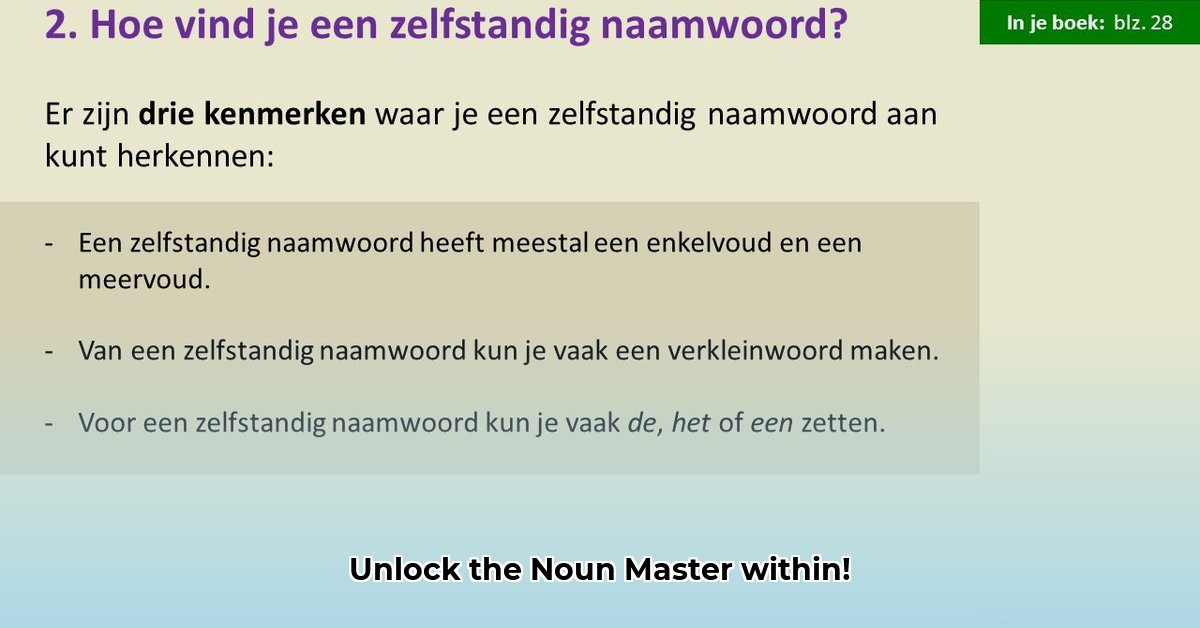
Wat is 'n Selfstandige Naamwoord (Noun)?
Ê, so you want to crack the code of Dutch nouns (selfstandige naamwoorde)? Don't be bang! This comprehensive guide will turn you into a noun-spotting champion. We'll cover everything from the basics to the trickiest parts, so buckle up!
A noun, jou basic building block of a sentence, names a person, place, thing, or idea. Think of it as the main character of the sentence – the one doing the action or having something done to it. Examples include huis (house), boom (tree), geluk (happiness), and Amsterdam (Amsterdam). See the difference between concrete things (like a huis) and abstract concepts (like geluk)? Getting this distinction will make identifying nouns much easier.
Hoe Vind Jy 'n Selfstandige Naamwoord in 'n Sin?
Spotting nouns in a sentence is like playing a linguistic game of I Spy! Here’s your cheat sheet:
Zero in on the verb (werkwoord): The verb shows the action. The noun is usually what’s doing the action (the subject) or what the action is happening to (the object).
Look for those articles (artikels): Words like "de" (the), "een" (a/an), and "het" (the) often signal a noun's presence. Did you know that "het" and "de" indicate noun gender in Dutch? We'll unpack that a bit later.
Ask the right questions: Ask "Who?" or "What?" after the verb. The answer is usually your noun!
For example: "Die hond blaf." (The dog barks.) Who barks? The dog. "Hond" (dog) is your noun. Easy peasy, right? But, what about more complex sentences? Let's explore how to tackle those tricky ones too.
Different Types of Nouns: 'n Dieper Kijk
Not all nouns are created equal! There's a whole family of them, each with its own personality:
Proper Nouns (Eienaamwoorde): These are names – like Suid-Afrika (South Africa), Shakespeare, or Rotterdam. They always start with a capital letter. Think of these as the VIPs of the noun world!
Common Nouns (Gewone Naamwoorde): These are general terms, like land (country), man (man), huis (house), motor (car). This might be a bit like spotting the "everyday" characters in a sentence.
Concrete Nouns (Konkrete Naamwoorde): These are things you can touch or see: a tafel (table), a boek (book), a koppie koffie (a cup of coffee). These are quite literal nouns!
Abstract Nouns (Abstrakte Naamwoorde): These are ideas or concepts you can't touch: vreugde (joy), haat (hate), verandering (change). These ones might require a little more cognitive flexing!
Collective Nouns (Versamelnaamwoorde): These represent groups of things – 'n kudde skape (a flock of sheep), 'n span spelers (a team of players). It's all about the collective here!
Noun Gender (de/het): The Great Divide
Now, for the tricky part: Dutch nouns have gender – de words (feminine/masculine/neuter) and het words (neuter). There isn't a consistent rule, so memorization is your best friend, especially at first. However, there are some patterns to help you remember better. Keep an eye out for those -ing words and those that end with -heid. There are some handy mnemonic tricks that really help here. Don’t worry – with enough practice, it'll become second nature! We'll focus on strategies to help you learn these better.
Plural Nouns (Meervoud) and Diminutives (Verkleinwoorde): Adding Nuance
Making a noun plural is often as simple as adding "-s" (huis becomes huise). But, kyk uit! There are irregular plurals – words that don't follow the rules, making them unique little exceptions.
Diminutives are words to use when it's adorable! They are smaller versions of nouns, often created by adding "-ie" (huisie – little house) or "-tjie" (bloumetjie – little blue flower).
Nouns in Sentences: Their Roles
Nouns aren't just hanging out; they have specific roles:
Subject (Onderwerp): The noun doing the action: "Die kat drink melk" (The cat drinks milk). The cat is the subject – the doer of the drinking.
Object (Voorwerp): The noun receiving the action: "Die man lees 'n boek" (The man reads a book). The book is the object – being acted upon.
Complement: Completes a verb or adjective: "Sy is 'n dokter" (She is a doctor). Dokter complements the verb "is," describing who "sy" is.
Common Mistakes to Avoid
A frequent slip-up is confusing adjectives (byvoeglike naamwoorde) with nouns. Remember, adjectives describe nouns, while nouns are the things being described. Don't be afraid to ask for help if you're still confused.
Let's Practice!
Test your new noun-finding skills! Identify the nouns in these sentences:
- Die blou voël sing 'n pragtige liedjie.
- Jan loop vinnig na die winkel.
- Genade is 'n wonderlike gawe.
Irregular Plural Nouns: The Exceptions
While many Dutch plurals simply add "-en" or "-s", many are irregular. These don't follow the rules, requiring memorization. Think of them as the exciting exceptions that add flavor to the language! Don't be discouraged - focus on the high-frequency words first.
Mastering Irregular Plurals: Tips and Tricks
Use flashcards, quizzes, and spaced repetition systems. Immerse yourself in Dutch media – books, music, films – to encounter these words naturally. Group similar irregular plurals to spot patterns and make memorization simpler.
Remember, mastering Dutch nouns takes time. Keep practicing, and you’ll soon be a noun-identifying pro! Sterkte! (Good luck!)